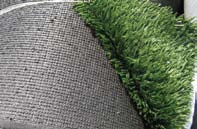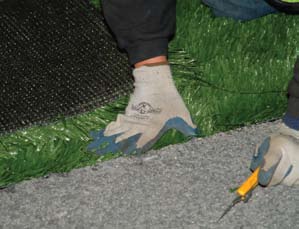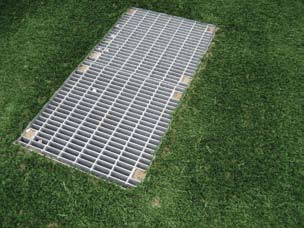John F. Kennedy International Airport (JFK) recently installed tens of thousands of square feet of carpet. But instead of cushioning the soles of flyers’ feet, the new synthetic fiber covers and protects its airfield.

In 2000, a certification inspection by the Federal Aviation Administration (FAA) found a number of areas around the edges of runways that had eroded and consequently required better stabilization.  The airport owner, Port Authority of New York and New Jersey (PANYNJ), subsequently conducted a runway safety area value engineering and constructability study. One of its higher-ranking suggestions was to install artificial turf.
The airport owner, Port Authority of New York and New Jersey (PANYNJ), subsequently conducted a runway safety area value engineering and constructability study. One of its higher-ranking suggestions was to install artificial turf.
“Because of the jet blast, grass simply wasn’t working,” says PANYNJ public information officer Pasquale DiFulco.
In the fall of 2006, the Port Authority awarded a contract of $744,000 to install two different artificial turf products. Crews installed roughly 90,000 square feet of product so airport authorities could observe how the materials stand up to JFK’s environmental conditions – runway activity, jet blast and rotation erosion in particular.
 Tully Construction excavated two independent areas and installed drainage to prepare the sites for the synthetic turf. “It was typical airport wildgrass, flora and hard-packed earth,” reports Tully project manager Ed White.
Tully Construction excavated two independent areas and installed drainage to prepare the sites for the synthetic turf. “It was typical airport wildgrass, flora and hard-packed earth,” reports Tully project manager Ed White.
The artificial turf vendors then installed their respective synthetic grass products. AvTurf president Joe Dobson says the JFK installation was very straightforward, much like his company’s seven other domestic airport installations. AvTurf is a 2.5-inch polyethelyne, polypropylene fiber that has a sand ballast to provide stability and assist in drainage and contaminant filtration, he explains.
 Dobson also highlights the sewing technique AvTurf used at JFK: Double-stitched nylon thread was used to join 25 panels at 15 feet wide and up to 220 feet long. Minimal glue was used in detail work around navigational aids and in areas where sewing equipment would not fit. AvTurf also used growth inhibitors to prevent airborne vegetation – a first, according to Dobson.
Dobson also highlights the sewing technique AvTurf used at JFK: Double-stitched nylon thread was used to join 25 panels at 15 feet wide and up to 220 feet long. Minimal glue was used in detail work around navigational aids and in areas where sewing equipment would not fit. AvTurf also used growth inhibitors to prevent airborne vegetation – a first, according to Dobson.
DiFulco says the project’s greatest challenges were the development of a contract for sole sourcing of a particular turf solution and the need to ensure runway safety at all times after installation.
“The concern was that (the turf) would break down and become foreign object debris (FOD), which would run completely counter to what we were hoping to accomplish out there,” he explains. “But the good news is that both installations appear to be extremely successful.
They are standing up to the environmental and operational conditions at JFK, and they look good. There has been very low or even no maintenance issues, and it looks like at this point, based on what we have observed, we seem to have solved the erosion issue.
“A year in, it looks like it has held up real well. Considering what it is subject to at an airport, it has certainly met our expectations.” ![]()


